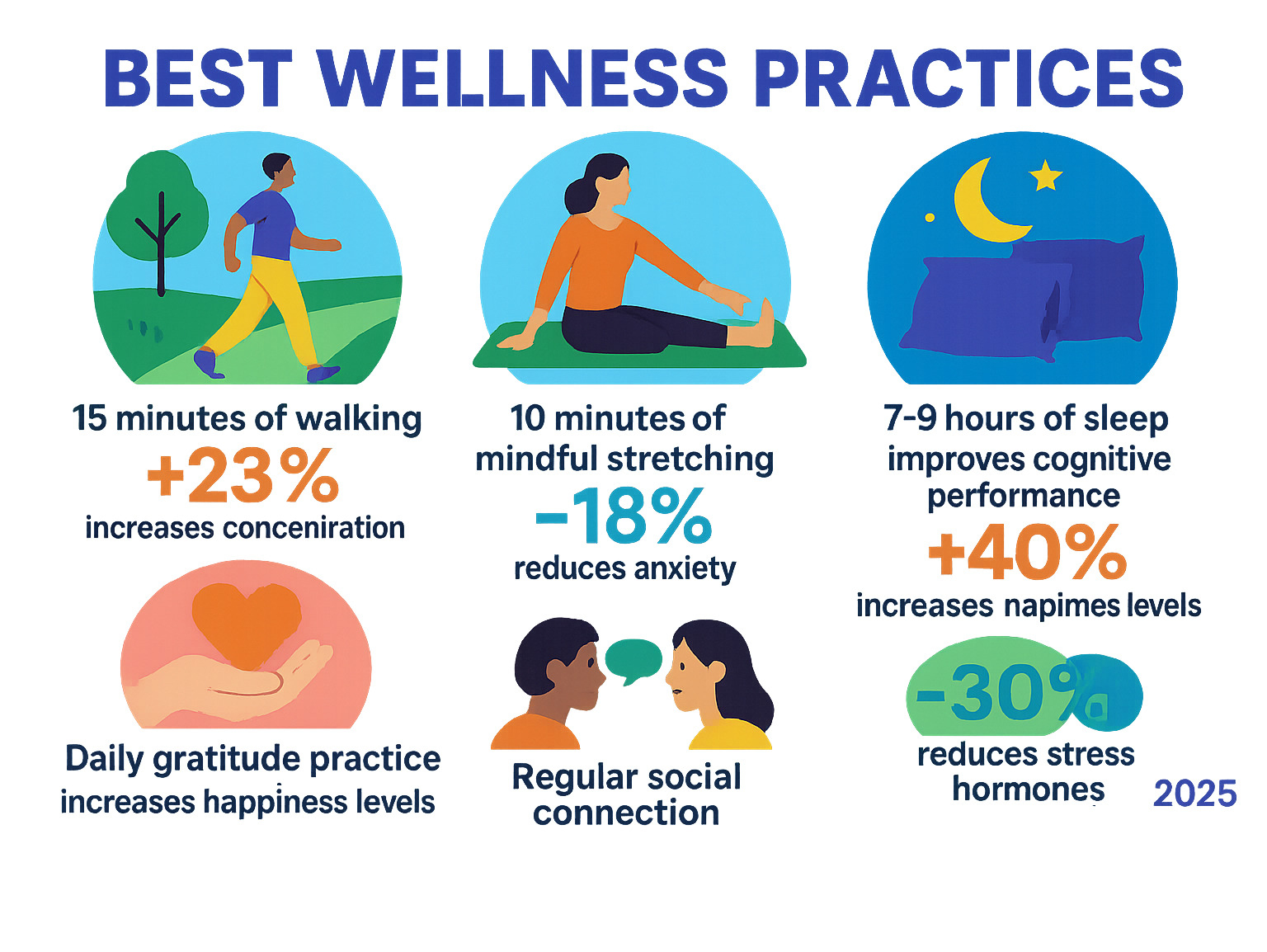Why Best Wellness Practices Are Your Key to a Transformed Life
Foundational Practices for Your Physical Well-being (Practices 1-6)
Your body is the vehicle for everything you do. These six best wellness practices keep it running smoothly without requiring expensive gear or marathon-level motivation.
1. Prioritize Mindful Movement
Your body craves movement, and the best part is it doesn’t require a gym. Movement is medicine. Research shows that 15 minutes of walking can boost concentration and energy. The key is making it mindful. Tune into your body during a walk or stretch. This turns simple movement into a form of moving meditation.
How to start:
- Take a 10-minute morning walk.
- Stretch for 5 minutes while watching TV.
- Try simple Yoga Poses for Better Posture and Beauty.
- Take the stairs or dance to a favorite song.
Every bit of movement releases endorphins, your body’s natural mood boosters.
2. Master Restorative Sleep
Sleep is your body’s nightly reset, repairing tissues and rebalancing hormones. Most adults need 7-9 hours of quality sleep each night. It’s not just about the hours; it’s about creating the right conditions for rest.
Master sleep hygiene:
- Keep a consistent sleep schedule, even on weekends.
- Create a cool, dark, quiet sanctuary. Put away devices an hour before bed to reduce blue light exposure.
- Avoid caffeine after 2 PM, as it can stay in your system for 6-8 hours.
Poor sleep is linked to serious health issues, so prioritizing it is an investment in your mental and physical vitality. A relaxing bedtime routine, like reading or gentle stretching, signals to your body that it’s time to wind down.
3. Fuel Your Body: One of the best wellness practices for energy
Food is fuel, and your body deserves high-quality nutrition. Eating well is about choosing whole foods that make you feel energized.
Build a vibrant plate:
- Fill half your plate with colorful vegetables for a full spectrum of vitamins and antioxidants.
- Include lean proteins (chicken, fish, beans) and whole grains (quinoa, brown rice) to stabilize blood sugar and prevent energy crashes.
- Don’t fear healthy fats from avocados, nuts, and olive oil; they support brain function.
Cooking at home gives you control over ingredients and portions. As The Connection Between Gut Health and Glowing Skin shows, good nutrition supports both inner wellness and outer beauty. Choosing real foods is one of the best wellness practices for sustained energy.
4. Stay Hydrated for Peak Performance
Your body is roughly 60% water, and even mild dehydration can cause fatigue and brain fog. Drinking at least eight glasses of water daily is a simple but powerful wellness practice.
Make hydration enjoyable:
- Start your morning with a glass of water to kickstart your metabolism.
- Infuse water with cucumber or fruit for flavor and electrolytes.
- Drink herbal teas, like green tea, which also provide heart-healthy flavonoids.
Keep a water bottle visible to remind yourself to drink. Proper hydration leads to reduced fatigue, improved concentration, and better-looking skin, with benefits you can feel within hours.
5. Accept an Invigorating Cold Blast
Ending your shower with a 30-second cold blast can be transformative. It might sound uncomfortable, but it’s like nature’s espresso shot. Research shows that icy temps help release endorphins, boosting energy and alertness with an antidepressant effect.
Cold exposure activates your sympathetic nervous system, increasing circulation and potentially boosting immune function. It’s a quick way to feel energized and accomplished.
How to start:
- Begin with 10-15 seconds of cold water at the end of your shower.
- Breathe deeply to manage the sensation.
- Gradually increase to 30 seconds or more.
If a full blast is too much, just splashing cold water on your face and wrists works too. You might find you look forward to the rush of increased energy and mental clarity.
6. Harness the Power of Your Breath
Your breath is one of the most accessible wellness tools you have. A few minutes of intentional breathing, or breathwork, can reduce stress and sharpen your focus.
Simple techniques to try:
- Box Breathing: When overwhelmed, inhale for 4 counts, hold for 4, exhale for 4, and hold for 4. This pattern calms your nervous system.
- Deep Belly Breathing: Place a hand on your belly and breathe so only that hand moves. This encourages deeper, more nourishing breaths.
- 4-7-8 Breathing: To relax, inhale for 4, hold for 7, and exhale for 8. This is great for winding down before sleep.
Unlike some practices, breathwork’s effects are immediate. As explored in The Power of Breathwork for Wellness and Inner Glow, this simple habit can transform your inner state. Start with just 2-3 minutes each morning to set a calmer tone for your day.
Nurturing a Resilient Mind (Practices 7-13)

Mental and emotional strength come from daily upkeep—just like teeth-brushing, but for your thoughts.
7. Practice Daily Mindfulness: One of the best wellness practices for stress
Mindfulness isn’t about emptying your mind; it’s about paying attention to the present moment without judgment. You can practice it anywhere, anytime. Just 15 minutes of daily mental health hygiene can improve your mood and sharpen your concentration.
Incorporate mindfulness into your day:
- While brushing your teeth, notice the minty taste and the sensation of the bristles.
- Before checking your phone, take three slow, conscious breaths.
- During meals, put down your fork between bites and truly taste your food.
Research shows mindfulness reduces the stress hormone cortisol. As the Relaxation Techniques for Health guide confirms, it’s a powerful, evidence-based tool. By turning routine tasks into mindfulness exercises, you support your mental health throughout the day. For more, explore How to Improve Mental Health.
8. Cultivate an Attitude of Gratitude
Gratitude shifts your perspective from scarcity to abundance. It’s not just feel-good advice; science shows gratitude can boost happiness and create lasting positive changes in your brain. People who practice it report improved sleep, reduced anxiety, and increased positive emotions.
Simple gratitude practices:
- Write down three things you’re grateful for each morning in a journal.
- Keep a gratitude jar and add one note weekly.
- Send a gratitude text to someone who brightened your day.
Even during challenges, asking, “What’s one thing going right today?” can be a powerful anchor. This practice doesn’t dismiss difficulties but helps you maintain perspective and resilience, spreading positivity to yourself and others.
9. Release Your Creativity with a Hobby
Creative hobbies offer a therapeutic escape from daily stress. Working with your hands quiets mental chatter and brings you into the present moment. Studies show making art can reduce anxiety by lowering cortisol levels, helping you enter a “flow state” where stress melts away.
Creative ideas to try:
- Doodle for 10 minutes to clear mental fog.
- Try knitting or pottery for their calming, repetitive motions.
- Play a musical instrument to boost cognitive function.
- Engage in creative writing or photography to find beauty in the everyday.
You don’t need to be an artist. The goal is to give your mind permission to play, explore, and heal. Choosing a hobby that genuinely interests you is one of the best wellness practices for mental well-being.
10. Take a Mindful Digital Detox
Constant notifications keep your nervous system on high alert. Taking breaks from technology is essential for mental wellness. Stepping away from screens gives your mind space to breathe and reset. Accept JOMO (the Joy of Missing Out) and find peace in being present.
Simple digital detox tips:
- Keep your phone in another room while sleeping. Use a real alarm clock.
- Designate phone-free meals to eat more mindfully.
- Try a 24-hour social media detox monthly to reset your relationship with these platforms.
- Create tech-free zones in your home, like the bedroom or dining room.
Reducing screen time improves focus, reduces anxiety, and helps you reconnect with yourself. As detailed in Digital Detox: A Wellness Reset for Your Mind and Skin, it’s one of the best wellness practices for both inner peace and outer glow.
11. Rewire Your Brain with Positive Affirmations
The voice in your head has incredible power. Positive affirmations are an effective way to rewire your brain for confidence. By consistently practicing positive self-talk, you change your neural pathways. Research links a hopeful viewpoint to better mental and physical health and lower blood pressure.
The key is choosing affirmations that feel authentic. Instead of “I’m perfect,” try “I am learning and growing every day.”
How to practice:
- Repeat affirmations during your morning routine.
- Write them in a journal or say them while looking in the mirror.
- Use present-tense, empowering statements like “I am capable of handling whatever comes my way” or “I choose peace over perfection.”
This practice helps build mental resilience and a more supportive relationship with yourself.
12. Try Emotional Freedom Techniques (EFT)
Emotional Freedom Techniques (EFT), or tapping, combines acupressure with psychology to help process stress and anxiety. It involves gently tapping on specific meridian points on your body while focusing on a troubling issue.
Research shows EFT can increase happiness and improve immune function. It’s a simple tool you can use anywhere.
How it works:
- Identify a problem and rate its intensity from 1-10.
- Tap on the side of your hand while stating the problem (e.g., “Even though I feel this stress, I accept myself.”).
- Tap on a sequence of points (eyebrow, side of eye, under eye, etc.) while repeating a reminder phrase.
- Take a deep breath and reassess the intensity.
Many find their stress level drops significantly after a few rounds. EFT is one of the best wellness practices for emotional health, acting as a portable tool to help you work through difficult feelings.
13. Curate a Mood-Boosting Playlist
The right song can instantly transform your mood. Music acts as an emotional reset button. When you listen to music you enjoy, your brain releases dopamine, the feel-good neurotransmitter. This makes music one of the most accessible best wellness practices.
Curate playlists for your needs:
- Energizing morning songs: Upbeat tracks to set a positive tone.
- Focus and concentration instrumentals: Calming music to quiet mental chatter while you work.
- Workout motivation tracks: High-energy songs to make exercise more enjoyable.
- Emotional release songs: Music that provides a safe space to process feelings, whether happy or sad.
Creating playlists on your phone or a streaming service is easy. Start with one for your most common need, like morning energy or evening relaxation, and harness music’s therapeutic power.
The Best Wellness Practices for a Connected Life (Practices 14-23)

Humans heal through connection—to people, spaces, nature, and purpose.
14. Nurture Your Social Connections
Human connection is essential for your well-being. A landmark 86-year Harvard study revealed that positive relationships are the strongest predictor of happiness and health—more so than money or career success.
When you spend time with people you care about, your body releases oxytocin, the “love hormone.” This chemical reduces stress, lowers blood pressure, and strengthens your immune system.
Nurturing connections is simple:
- Call a friend just to check in.
- Schedule regular coffee dates.
- Practice active listening in conversations.
Quality matters more than quantity. Even one or two meaningful relationships can significantly impact your happiness and longevity. Make social connection one of your best wellness practices by treating it as a vital part of your health.
15. Lean into the Power of Physical Touch
Physical touch is a powerful wellness practice that directly impacts your nervous system. Recent research on physical touch shows it lowers cortisol levels (the stress hormone) and reduces pain, depression, and anxiety.
Simple ways to incorporate touch:
- A 20-second hug with a loved one can shift your mood.
- Regular massages support your immune system.
- Gentle self-touch, like a hand massage, can activate your body’s relaxation response.
- Hold hands with a partner or pet an animal.
Even brief, appropriate physical contact makes a measurable difference. Your skin is your largest organ, designed to connect you with the world and the people you care about.
16. Bond with an Animal Companion
The bond with an animal can be a powerful buffer against stress, lowering blood pressure and heart rate. When you interact with animals, your body releases oxytocin and dopamine while reducing cortisol.
You don’t need to own a pet to experience these benefits. Spending quality time with a friend’s pet or volunteering at an animal shelter provides immediate stress relief. Many communities also offer pet therapy programs.
For those who prefer wildlife, birdwatching offers a peaceful way to connect with nature. The simple act of caring for another living being, or just observing one, creates structure and invites you to live in the present moment. This human-animal connection is one of the most joyful best wellness practices.
17. Declutter Your Physical Environment
Your surroundings deeply impact your mental state. A cluttered environment can increase cortisol levels and make it hard to focus. Your brain sees clutter as unfinished business, creating low-level stress.
Simple ways to declutter:
- Start with one small area, like a single drawer, to build momentum.
- Use the “one in, one out” rule: when you bring something new in, remove something old.
- Create designated spaces for important items like keys and documents.
- Use natural cleaning products to improve indoor air quality.
- Add plants to purify the air and boost your mood.
As Eco-Wellness Practices explains, a clean, sustainable environment supports personal health. The goal isn’t perfection, but a peaceful space that works for you.
18. Ground Yourself in Nature
Stepping outside to breathe fresh air can clear your mind and relax your body. Spending time in nature is one of the best wellness practices for mental and physical health. Just 30 minutes of outdoor time daily can reduce stress hormones, lower blood pressure, and boost your mood.
Simple ways to connect with nature:
- Take a 10-minute walk around your neighborhood.
- Practice earthing by walking barefoot on grass or sand to feel grounded.
- Try gardening, which combines physical activity with the satisfaction of nurturing growth.
- Do outdoor meditation or yoga to deepen your connection.
Even in an urban area, seek out parks or tree-lined streets. Making nature a regular part of your routine is a simple yet powerful way to support your well-being.
19. Stimulate Your Mind with Lifelong Learning
Your brain thrives on novelty and challenge. Intellectual wellness is about staying curious and continuously growing.
Ways to stimulate your mind:
- Read fiction or non-fiction to exercise your brain and reduce stress.
- Do puzzles and brain games like sudoku or crosswords to maintain mental agility.
- Take online courses or workshops on a subject that sparks your interest.
- Learn a new language or musical instrument, both of which are excellent for brain health.
- Engage in thoughtful discussions to process new ideas and see different perspectives.
Choose activities that feel like play, not work. As highlighted in our guide to Holistic Wellness Books, lifelong learning is a key component of well-being. It’s about maintaining an active, curious mind.
20. Reduce Stress with Financial Planning
Money worries are a major source of stress. Financial wellness is deeply connected to your mental and emotional health. Feeling secure about your finances frees up energy for other areas of your life.
Key steps to financial wellness:
- Create a realistic budget by tracking your spending to see where your money goes.
- Build an emergency fund. Start small by setting aside $10 a week. Having a cushion prevents minor issues from becoming major crises.
- Set clear financial goals, like paying off debt or saving for a vacation, to make budgeting feel purposeful.
The sense of security from financial planning reduces anxiety and improves overall health. It’s not about being wealthy; it’s about feeling in control of your money.
21. Find Purpose Through Volunteering
Shifting your focus to helping others creates a powerful sense of purpose. Volunteering connects you to your community and boosts your own happiness and life satisfaction.
Ways to find purpose through service:
- Help at local food banks or shelters to make an immediate difference.
- Join environmental cleanup projects to connect with nature while improving your community.
- Become a mentor to share your knowledge and experience.
- Volunteer with animal rescue organizations to care for vulnerable creatures.
Finding opportunities that align with your values is key. When you care about the cause, volunteering becomes a natural extension of who you are and one of the most rewarding best wellness practices.
22. Step Out of Your Comfort Zone
Growth happens when you gently push beyond what feels safe. Stepping out of your comfort zone is a powerful practice for building resilience and confidence. While your comfort zone is a safe haven, staying there can lead to stagnation.
The magic happens in mild discomfort, not terror.
Small steps to expand your world:
- Try a new hobby like pottery or salsa dancing.
- Travel to a new place, even if it’s just a new neighborhood in your city.
- Meet new people by joining a group or attending a community event.
- Say yes to invitations that make you slightly nervous.
Each small step builds confidence to tackle the next. Growth requires discomfort, but the rewards are immense: increased self-confidence and a richer, more interesting life.
23. Practice Intentional Acts of Kindness
Kindness benefits both the giver and receiver. Research shows that being kind can lower blood pressure and reduce stress.
Daily kindness practices:
- Compliment someone genuinely
- Thank service workers
- Help a neighbor with a task
- Send encouraging messages to friends
- Practice patience with difficult people
- Be kind to yourself in your self-talk
Small acts of kindness create ripple effects that boost your own well-being and that of your entire community.

How to Build Lasting Wellness Habits
- Start small: Pick one micro-habit that takes under five minutes.
- Stack it: Attach the new habit to something you already do (e.g., breathe deeply after brushing teeth).
- Track it: Mark a calendar or use the Monthly Self-Care Planner for motivation.
Consistency – not perfection – turns actions into automatic routines.
Frequently Asked Questions
Which dimensions matter most? All eight work together. Improving one (like physical) often boosts another (like mental).
When will I feel results? Some benefits are instant (deep breaths), most appear in 2-4 weeks of consistency, and long-term gains arrive within months.
When to seek professional help? If low mood, anxiety, or addiction persist despite self-care, reach out to a licensed therapist or physician. Resources: NIMH Depression Basics.
Your Journey to Zen Starts Now

Pick one best wellness practice that resonated and try it for seven days. Notice the shift, celebrate it, then add another seed to your routine. Small, loving actions grow into lifelong vitality.
Ready for more guidance? Explore additional resources at Beyond Beauty Lab – your partner on the path from meh to zen.







